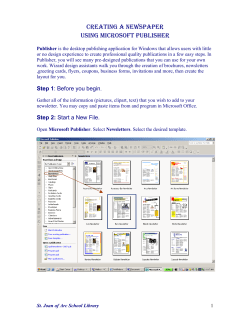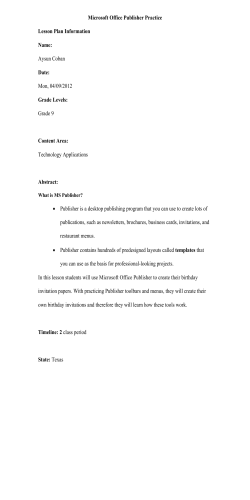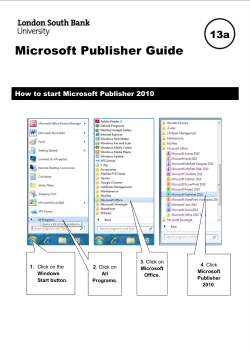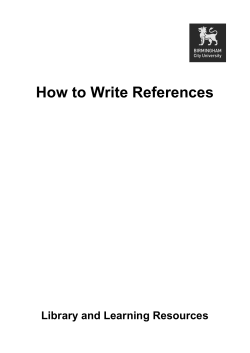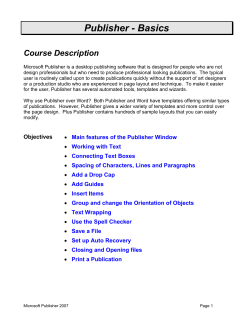
Document 199801
How to use your Desk Top Publisher as a Building Tool A Manual by Gary Robert McKay Index Technical Manual Sample 1. Cover 2. A Building and Construction System 3. Designing a Template in MS Publisher Designing a template in MS Publiser MS Publisher as a Drawing Board 2 MS Publisher as a drawing board 4 Types of parts for MS Publisher 5 How to write component instructions Laminating Creating Open Units D-Unit tower parts supplied free with this manual. The tools to use Engineering in Paper — open ended exploration 6 Three kinds of parts to use in MS Publisher 7 Making Apertures 8 Laminating 9 Using Auto Shapes for constructions in MS Publisher 10 Creating Fabric Pages in MS Publisher 11 Tools to Use Proof of concept: Designed and built with MS Publisher ® the XP2A-4 rocket in flight, Cygnet, Tasmania, 11/01/09. 12 About the Author 13 Instructions for D-Unit Tower Free EIP Parts Board D-Unit Tower The prototype craft and launching system are now in the collection of the Tasmanian Museum and Art Gallery (TMAG). 14 D-Unit template 15 D-Unit template graphics ready 16 D-Unit template for apertures 17 Braces DU-1 D-Unit solid planes DU-2 D-Unit open DU-3 Graphics ready DU-4 60º Brace DU-5 60º Brace © 2012 Gary Robert McKay with additional images by Maurice Sartorelli. © 2009 Maurice Sartorelli. All rights reserved. Content being instructional pictures and text are the copyrighted property of the author. All templates are copy left, open source and can be freely used and passed on and you may publish their development. All references to MS Publisher ® and product screen shots are for the purposes of review only and I have no association with Microsoft Corporation. I just wish them well! Education purchasers have all of school rights. How to use your Desk Top Publisher as a Building Tool 1 2. A Building and Construction System Summary Engineering-in-Paper builds component by component from computer drawn parts and print-outs. It can be material by print outs as applied to any flat using the This manual outlines a simple approach to making with print outs that is, in fact, a building and construction system for paper or any flat sheeting. sheet Computer Drawn The first section of this manual deals with the technical aspects of building using MS Publisher ® as an example.. Part On this page are the basic terms used in this manual. We call the technique Engineering-in-Paper (EIP). Glue Tab Brace Plane How to use your Desk Top Publisher as a Building Tool 2 3 Designing a Part in MS Publisher ® Summary Use of planes and glue tabs to create a part using the shapes using the example of the MS Publisher drawing system. This is the development of a rocket nose cone. We show how the nose cone on this rocket was designed. Step One Cone shape to correct size—matching fuselage– is imported from shapes. Left: the part on the page and below on the cutting Step Two Glue tabs established at top and bottom of plane. The tip of the cone is a unique interleaving trian- Step Four The object in Step Three Step Three The shape in step two is copied, pasted and rotated to create required Is grouped an overdrawn to be graphics ready. How to use your Desk Top Publisher as a Building Tool 3 4 MS Publisher ® as a Drawing Board Summary How to use MS Publisher 2007 as a drawing board. Set position on page Set size of object Rotate object to tenth of degree Measurement toolbar can be dragged onto to top tool Below: Use of Basic Shapes to create parts Plane Glue tab Plane Tip: hold down shift key when placing and sizing triangle for equilateral form. How to use your Desk Top Publisher as a Building Tool 4 5 How to write component Some people like words, some like diagrams so part instruction are best in both forms. This is the tail plane stabiliser for the OST Z2 Rocket - and is our most complex part to date. Note that direction of fold has to indicated and followed carefully by the builder. Z2-10 Tail Plane Stabiliser ABC D I Interleave and glue together U U Meet and glue R U K J D L D IKLNOQ Glue to tail plane wing RST Grey Areas Glue to tail Remove (Cut) D E M U D A D B D I K J S U F N U C D R U U G D H D O P Q U T U E How to use your Desk Top Publisher as a Building Tool 5 6 Three kinds of parts In the OST approach there are three kinds of parts. Summary There are three kinds of EIP Parts Solid plane drawings clearly showing planes and glue tabs. Used during development and prototyping—and also to see where things go. Open units ready for the cutting of apertures Graphics ready drawings which have no internal lines to interfere with the placement of graphics. Graphics ready Externally marked ruler guides for scoring folds area Solid plane drawing—see where everything goes Graphics ready part Aperture marked face—see instructions next page How to use your Desk Top Publisher as a Building Tool 6 7 Making apertures Summary Creating apertures in D-Units and other structures. B B A A A B Red lines indicate to cut Underside of TAB A glues to Plane B How to use your Desk Top Publisher as a Building Tool 7 Laminating Summary This is a desk top version of laminating two flat sheetings together. The example is aluminium foil but works with other materials e.g. plastic films like Glad Wrap ® Use pastes (e.g. glue stick) rather than adhesives Above: Proto-type rocket launch stand made with paper laminated with Cut excess from print out and smear non-printed side with glue stick. Pay particular attention to areas which will become the edges of the part. Use scissors to cut shape— the shearing effect of the scissors helps to seal the edges Placement of 60 degree brace Smooth foil onto pasted area. Two laminated parts ready for assembly Trim off excess foil, turn over and use printed lines to score in fold lines How to use your Desk Top Publisher as a Building Tool 8 8 Using Autoshapes for constructions in MS Publisher ® 2V-1 2V-2 AS2V-2 AS2V-1 2V-3 To personalise Autoshape from toolbar: Format> Autoshape> Fill: Colour< Fill Effects> Then choose from: Gradient, Texture, Pattern, Picture or Tint How to use your Desk Top Publisher as a Building Tool 9 9 Creating Fabric Pages in MS Publisher ® Summary Use graphics to turn paper into a patterned fabric. The watch tower form left is made with the Page Background in MS Publisher set to White Marble and with a random Filled Shapes. How to use your Desk Top Publisher as a Building Tool 10 10 Tools to Use Summary Simple hand tools to use on the marked up cutting board Any 2D drawing system can be used to create parts i.e. manual or computer based drawing. From manual drawings one can photocopy parts. We use MS Publisher because it is a common denominator drawing system—and does the job very well. Tools: Steel Rulers Scissors Blade Cutter White Ball Point—Fine —or same colour as paper or card (.Any biro can be used but blue or black lines, for example, tend to look messy). Chop Stick Glues Adhesives and Pastes Alligator nose pliers for firming glue tabs All kind of papers foils and plastic films Use white ball point pen to score fold lines. Use a white fine ball point to score fold lines because it does not damage the paper surface. The accuracy of the folds determine the accuracy of the construct. Well lit working area Computer Printer. Note: The styrene copolymer of printed laser printer inks unsticks at contact with acetone adhesives. All models in this manual are made on ink jet printers when this glue is used Note: Acetone glue (e.g.Tarzan’s grip) not recommended for children in school years K-6. Use glue sticks for this age. It’s not just for health reasons—acetone glues can be a disaster for clothes and furnishings. Warning: sniffing glues and solvents only makes you ill. How to use your Desk Top Publisher as a Building Tool 11 15 About the Author Gary Robert McKay is a Tasmanian teacher and writer and a student at the School of Art and the School of Management at the University of Tasmania. He first developed the rudiments of Engineering –in -Paper whilst managing a small printery and publishing company. Retailers wanted a way of organizing product of the counter top and finding nothing “off the shelf” he developed his own, drawing parts on an engineer’s drafting board and photo-copying the results. He noticed that the system could be adapted to other purposes and used these in his own teaching practice during the nineties. In 2006 he decided to develop this early work with computer drawn parts and began the work that was to become Engineering-in-Paper. He has developed it as a bullding and construction system for any desk top publisher though his personal preference is MS Publisher Born in 1952, he lives in Hobart, Tasmania and is the father of four children. How to use your Desk Top Publisher as a Building Tool 12 16 Instructions D-Unit Tower Summary D-Unit is made from three diamond shapes Unit is reinforced by 60 degree brace Units other to make tower. assemble of top of each Can be stabilised with paper streamers as “guy wires”. This is a D-Unit made from three diamond shapes U D D U D U = Upward fold Made strip of three diamond shapes Bring ends of three diamond shapes as a strip and glue. D = Downward fold Paper clips How to use your Desk Top Publisher as a Building Tool 13 OST Templates Copyleft DU-1 All planes shown How to use your Desk Top Publisher as a Building Tool 14 OST Templates Copyleft DU-2 Apertures marked How to use your Desk Top Publisher as a Building Tool 15 OST Templates Copyleft DU-4 Corner brace all planes shown DU-5 Corner brace graphics ready How to use your Desk Top Publisher as a Building Tool 16
© Copyright 2024
